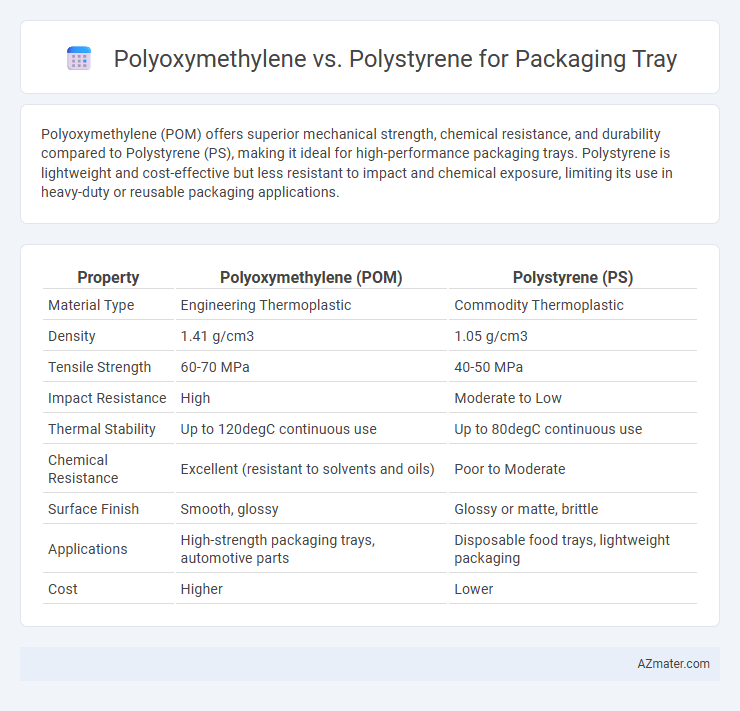Polyoxymethylene (POM) offers superior mechanical strength, chemical resistance, and durability compared to Polystyrene (PS), making it ideal for high-performance packaging trays. Polystyrene is lightweight and cost-effective but less resistant to impact and chemical exposure, limiting its use in heavy-duty or reusable packaging applications.
Table of Comparison
| Property | Polyoxymethylene (POM) | Polystyrene (PS) |
|---|---|---|
| Material Type | Engineering Thermoplastic | Commodity Thermoplastic |
| Density | 1.41 g/cm3 | 1.05 g/cm3 |
| Tensile Strength | 60-70 MPa | 40-50 MPa |
| Impact Resistance | High | Moderate to Low |
| Thermal Stability | Up to 120degC continuous use | Up to 80degC continuous use |
| Chemical Resistance | Excellent (resistant to solvents and oils) | Poor to Moderate |
| Surface Finish | Smooth, glossy | Glossy or matte, brittle |
| Applications | High-strength packaging trays, automotive parts | Disposable food trays, lightweight packaging |
| Cost | Higher | Lower |
Introduction to Polyoxymethylene and Polystyrene
Polyoxymethylene (POM) is a high-performance engineering thermoplastic known for its excellent mechanical strength, dimensional stability, and resistance to wear and chemicals, making it suitable for durable packaging trays requiring precision and longevity. Polystyrene (PS), a versatile and cost-effective thermoplastic, offers good clarity, rigidity, and ease of thermoforming, frequently used in lightweight disposable packaging trays for food and consumer goods. The choice between POM and PS depends on packaging requirements such as durability, thermal resistance, and cost, with POM favored for heavy-duty applications and PS preferred for economical, single-use trays.
Material Properties Overview
Polyoxymethylene (POM) offers exceptional mechanical strength, high stiffness, and excellent dimensional stability, making it ideal for durable packaging trays requiring resistance to wear and fatigue. Polystyrene (PS) provides good rigidity and clarity with excellent ease of fabrication, suitable for disposable or lightweight packaging applications where transparency is important. POM's superior chemical resistance and low moisture absorption outperform PS, which tends to be more brittle and less resistant to solvents in long-term use.
Mechanical Strength Comparison
Polyoxymethylene (POM) exhibits superior mechanical strength compared to polystyrene (PS), with higher tensile strength and impact resistance essential for durable packaging trays. POM's robust molecular structure provides excellent stiffness and fatigue resistance, ensuring long-lasting performance under stress. In contrast, polystyrene tends to be more brittle and less resistant to mechanical deformation, making it less suitable for heavy-duty packaging applications.
Chemical Resistance and Durability
Polyoxymethylene (POM) offers superior chemical resistance compared to Polystyrene (PS), effectively withstanding solvents, fuels, and alkalis, making it ideal for packaging trays exposed to harsh chemicals. POM exhibits high mechanical strength and excellent wear resistance, ensuring greater durability and longevity under repeated stress and impact. Polystyrene, while economical and rigid, is more prone to chemical degradation and brittle failure, limiting its use in demanding packaging applications requiring robust chemical resistance and durability.
Thermal Stability and Performance
Polyoxymethylene (POM) offers superior thermal stability for packaging trays, maintaining its mechanical properties and dimensional integrity at temperatures up to 120degC, making it ideal for applications involving heat exposure. Polystyrene (PS), while economically favorable, exhibits lower thermal resistance, typically softening around 90degC, which limits its use in high-temperature environments and may lead to deformation or loss of structural integrity. The enhanced thermal performance of POM supports its use in packaging requiring durability under thermal stress, whereas PS is better suited for cold or ambient temperature packaging due to its limited heat resistance.
Food Safety and Regulatory Compliance
Polyoxymethylene (POM) offers superior chemical resistance and dimensional stability compared to Polystyrene (PS), making it a safer choice for food packaging trays that require stringent hygiene standards. POM complies with FDA and EU food contact regulations, ensuring no harmful migration of substances into food, whereas polystyrene may pose risks due to styrene monomer leaching under certain conditions. Regulatory compliance and food safety certifications favor polyoxymethylene for packaging applications demanding durability and long-term contact with food products.
Environmental Impact and Sustainability
Polyoxymethylene (POM) exhibits higher durability and chemical resistance than Polystyrene (PS), resulting in longer lifecycle use and reduced waste generation for packaging trays. Polystyrene, widely used for its lightweight and cost-effectiveness, poses significant environmental concerns due to its low biodegradability and high potential for microplastic pollution. Selecting POM over PS enhances sustainability by enabling greater recyclability and reduced ecological footprint in packaging applications.
Cost Analysis for Packaging Applications
Polyoxymethylene (POM) offers superior mechanical strength and chemical resistance for packaging trays but comes at a higher raw material cost compared to Polystyrene (PS), which is more economical and widely used for disposable packaging. Polystyrene's lower density and ease of molding contribute to reduced manufacturing expenses, making it cost-effective for large-volume applications despite its limited durability. Assessing total cost for packaging involves balancing POM's longevity and reusability benefits against PS's affordability and suitability for short-term use.
Typical Use Cases in Packaging Trays
Polyoxymethylene (POM) is favored for packaging trays requiring high mechanical strength, chemical resistance, and dimensional stability, making it ideal for reusable medical or electronics packaging where durability and precision fit are crucial. Polystyrene (PS) is commonly used in disposable packaging trays for food products due to its clarity, ease of thermoforming, and cost-effectiveness, supporting applications like bakery trays or fresh produce containers. The choice between POM and PS depends primarily on the packaging tray's need for longevity, environmental exposure, and product protection requirements.
Key Factors for Material Selection
Polyoxymethylene (POM) offers superior mechanical strength, chemical resistance, and dimensional stability compared to Polystyrene (PS), making it ideal for packaging trays requiring durability and precision. Polystyrene is more cost-effective with excellent clarity and ease of molding but lacks POM's impact resistance and long-term thermal stability. Key factors for material selection include chemical exposure, mechanical load, temperature tolerance, and cost constraints relevant to packaging tray performance and lifespan.

Infographic: Polyoxymethylene vs Polystyrene for Packaging tray
 azmater.com
azmater.com